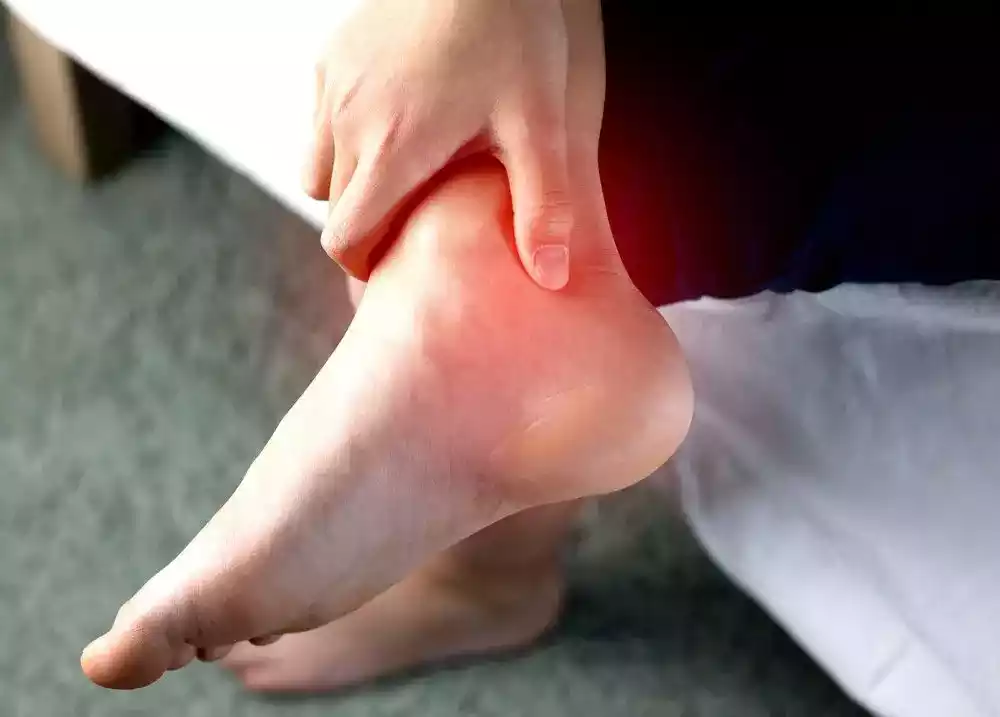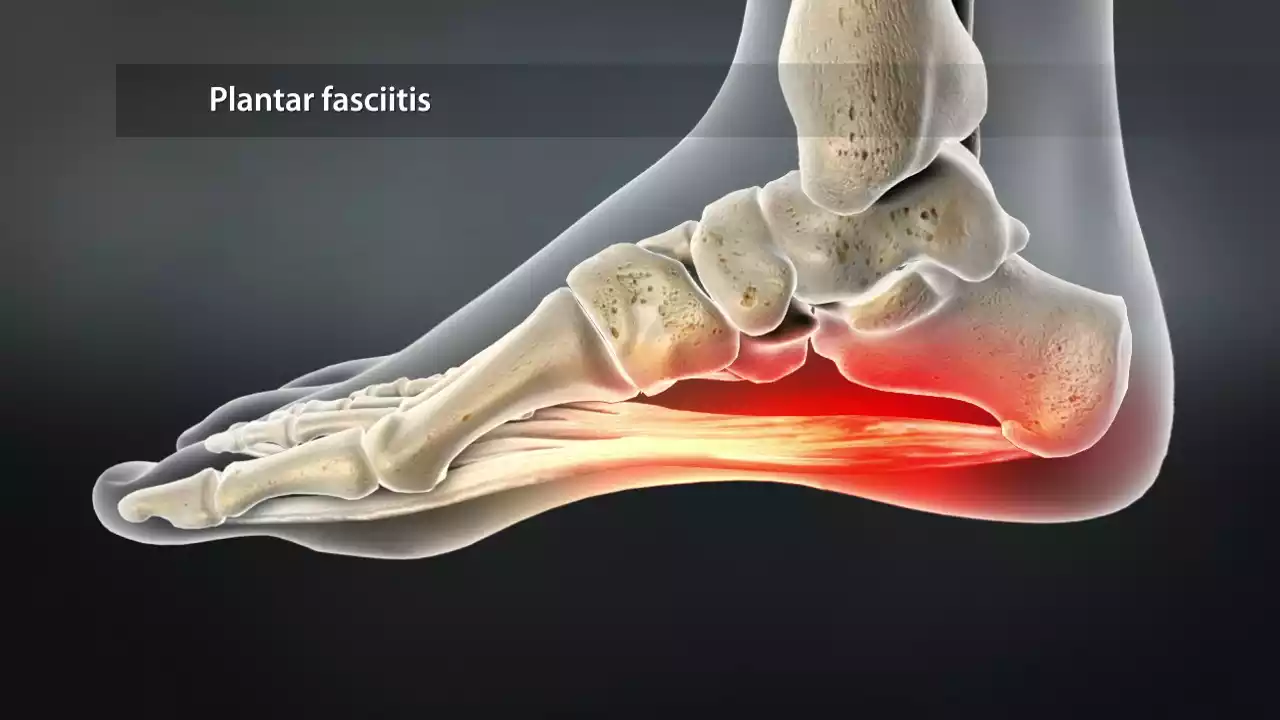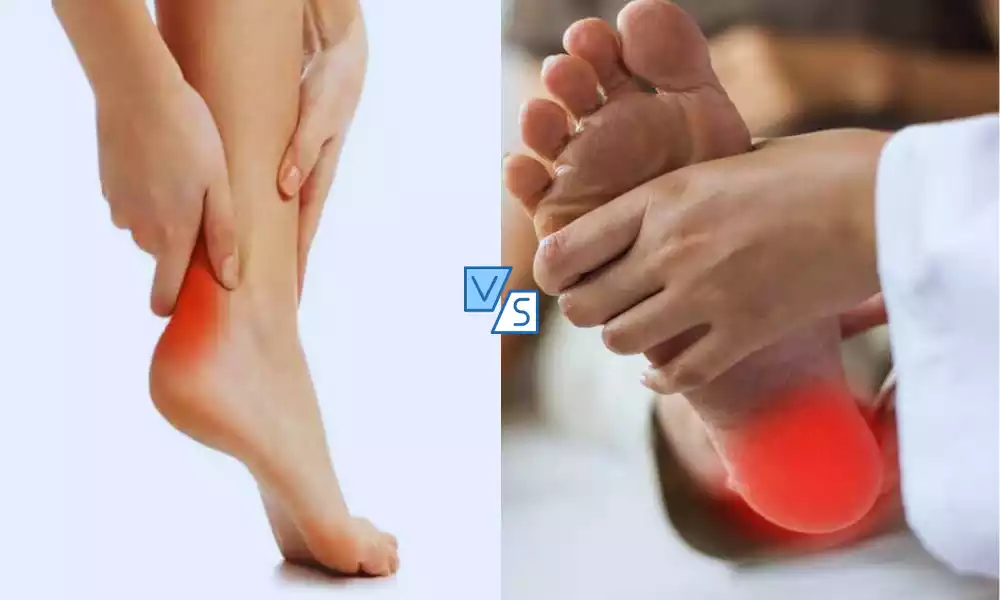Achilles Tendonitis and Plantar Fasciitis are both common musculoskeletal conditions that affect the lower extremities, but they involve different anatomical structures and present distinct sets of symptoms. Achilles Tendonitis is characterized by inflammation and pain in the Achilles tendon, which connects the calf muscles to the heel bone.
Plantar Fasciitis involves inflammation of the plantar fascia, a thick band of tissue that runs along the bottom of the foot, causing heel pain and discomfort, especially during the first steps in the morning. Knowledge of these two conditions is paramount for providing accurate diagnosis and effective treatments.
What is Achilles Tendonitis?
Achilles tendonitis, also known as Achilles tendinitis, is a medical condition characterized by inflammation, irritation, or degeneration of the Achilles tendon. The Achilles tendon is the thick, cord-like structure that connects the calf muscles to the heel bone (calcaneus). This condition typically results from overuse, repetitive stress, or strain on the Achilles tendon, leading to pain and stiffness in the back of the heel and lower calf.

Achilles tendonitis is a common injury among athletes and individuals who engage in activities that involve frequent jumping, running, or sudden increases in physical activity. It can range from mild discomfort to severe pain, and prompt treatment is essential to prevent further complications.
Causes of Achilles Tendonitis
Achilles tendonitis is typically caused by overuse or repetitive stress on the Achilles tendon, which is the thick cord-like structure that connects the calf muscles to the heel bone (calcaneus).
The main causes and risk factors for Achilles tendonitis include:
-
- Excessive Physical Activity: Engaging in sports or activities that involve repetitive and strenuous movements of the calf muscles and Achilles tendon, such as running, jumping, or sudden increases in activity level, can lead to tendonitis.
- Inadequate Warm-up or Stretching: Failing to properly warm up or stretch before physical activity can put extra strain on the Achilles tendon, increasing the risk of injury.
- Tight Calf Muscles: Tight calf muscles can increase the stress on the Achilles tendon during movement, making it more susceptible to inflammation and injury.
- Improper Footwear: Wearing shoes that lack proper support or do not fit well can contribute to the development of Achilles tendonitis.
- Biomechanical Issues: Abnormal foot arches or gait abnormalities can alter the mechanics of the foot and leg, leading to increased stress on the Achilles tendon.
- Age: Tendons tend to become less flexible and more prone to injury as a person ages, making older individuals more susceptible to Achilles tendonitis.
- Previous Injuries: A history of previous Achilles tendon injuries or conditions can weaken the tendon and increase the risk of future tendonitis.
- Sudden Changes in Activity Level: A rapid increase in the intensity, duration, or frequency of physical activity can strain the Achilles tendon.
- Medical Conditions: Certain medical conditions, such as obesity, diabetes, and high blood pressure, may increase the risk of developing Achilles tendonitis.
- Medications: Some medications, like fluoroquinolone antibiotics, have been associated with an increased risk of tendonitis, including Achilles tendonitis.
While these are common causes and risk factors, each individual may have unique factors contributing to their Achilles tendonitis. Proper diagnosis and treatment by a healthcare professional are essential for effectively managing this condition.
Symptoms of Achilles Tendonitis
Achilles tendonitis is characterized by several distinct symptoms, primarily involving pain and discomfort in the area around the Achilles tendon, which connects the calf muscles to the heel bone (calcaneus).
Common symptoms of Achilles tendonitis include:
-
- Pain: Pain is the hallmark symptom of Achilles tendonitis. The pain is typically felt along the back of the heel, near the attachment of the Achilles tendon to the heel bone. It can range from mild to severe and may be described as a dull ache, burning sensation, or sharp pain.
- Stiffness: Individuals with Achilles tendonitis often experience stiffness in the affected tendon, particularly in the morning or after periods of rest. This stiffness can gradually improve with movement but may return after periods of inactivity.
- Swelling: Inflammation of the Achilles tendon can lead to localized swelling around the heel area. Swelling may contribute to the feeling of tightness and discomfort.
- Tenderness: The Achilles tendon becomes tender to the touch, especially along the back of the heel. Pressing on the affected area may elicit pain.
- Reduced Range of Motion: Achilles tendonitis can limit the range of motion in the ankle joint, making it difficult to flex the foot upward (dorsiflexion). This reduced range of motion can exacerbate discomfort during activities that involve ankle movement.
- Weakness: Some individuals may experience weakness in the calf muscle, which can result from pain and inflammation in the Achilles tendon.
- Increased Pain with Activity: Pain often worsens with physical activity, especially activities that involve running, jumping, or pushing off with the toes. The pain may improve with rest but tends to return upon resuming activity.
- Crepitus: In some cases, there may be a crackling or grating sensation (crepitus) when moving the Achilles tendon. This may indicate the presence of small tendon tears.
The severity of Achilles tendonitis symptoms can vary from person to person. In some cases, the condition may progress to a more chronic or degenerative state if not properly managed. If you suspect you have Achilles tendonitis or are experiencing any of these symptoms, it is advisable to seek medical evaluation and treatment to prevent further complications and promote healing.
What is Plantar Fasciitis?
Plantar fasciitis is a common medical condition characterized by inflammation or irritation of the plantar fascia, which is a thick band of connective tissue that runs along the bottom of the foot. This condition typically causes stabbing or sharp heel pain, particularly when taking the first steps after resting or when getting up in the morning.

Plantar fasciitis is often associated with overuse, biomechanical issues, or repetitive strain on the foot, and it is a frequent cause of heel pain in adults. Treatment usually includes rest, stretching exercises, orthotic devices, and in some cases, medical interventions like corticosteroid injections or physical therapy to alleviate symptoms and promote healing.
Causes of Plantar Fasciitis
Plantar fasciitis is an increasingly prevalent condition characterized by discomfort and inflammation of the plantar fascia – a thick band of tissue found underfoot. The exact cause of plantar fasciitis is not always clear, but several factors and risk factors are associated with its development.
Common causes and contributing factors include:
-
- Overuse or Excessive Activity: Engaging in activities that place repetitive stress on the plantar fascia, such as running, walking long distances, or standing for extended periods, can lead to microtears and inflammation in the fascia.
- Improper Footwear: Wearing shoes that lack proper arch support, cushioning, or do not fit well can strain the plantar fascia and contribute to the development of plantar fasciitis.
- Foot Structure and Biomechanics: Abnormal foot arches, such as flat feet or high arches, can alter the distribution of weight and strain on the plantar fascia, increasing the risk of injury.
- Sudden Changes in Activity Level: A rapid increase in the intensity, duration, or frequency of physical activity can strain the plantar fascia, especially when the body is not adequately conditioned for the change.
- Obesity or Excess Body Weight: Excess body weight places additional stress on the plantar fascia, increasing the risk of inflammation and injury.
- Age: As individuals age, the plantar fascia can lose some of its elasticity and become more prone to injury.
- Occupational Factors: Jobs that require prolonged periods of standing or walking on hard surfaces can increase the risk of developing plantar fasciitis.
- Tight Calf Muscles and Achilles Tendon: Tight calf muscles can affect the flexibility of the Achilles tendon, which is connected to the plantar fascia. This can lead to increased strain on the fascia.
- Biomechanical Issues: Gait abnormalities or problems with foot mechanics, such as overpronation (excessive inward rolling of the foot), can contribute to plantar fasciitis.
- Inadequate Foot Support: Walking barefoot or using unsupportive footwear on hard surfaces can place undue stress on the plantar fascia.
- Previous Injuries or Conditions: A history of foot or leg injuries, as well as certain medical conditions like rheumatoid arthritis, may increase the risk of plantar fasciitis.
While these factors are associated with the development of plantar fasciitis, it’s important to note that the condition can also occur without any specific identifiable cause. Early intervention and appropriate treatment are essential for managing plantar fasciitis and reducing pain and discomfort. Individuals experiencing symptoms of plantar fasciitis should seek evaluation and care from a healthcare professional.
Symptoms of Plantar Fasciitis
Plantar fasciitis is characterized by several distinctive symptoms, primarily related to pain and discomfort in the heel and the bottom of the foot. Common symptoms of plantar fasciitis include:
- Heel Pain: The hallmark symptom of plantar fasciitis is intense pain in the heel, typically felt at the front and bottom of the heel bone (calcaneus). This pain can be sharp, stabbing, or throbbing and is often most severe with the first few steps in the morning or after periods of rest.
- Pain After Rest: Pain and discomfort tend to worsen after periods of inactivity, such as when getting out of bed in the morning or after sitting for an extended period. This is known as post-static dyskinesia.
- Pain with Weight-Bearing Activities: Activities that involve standing, walking, running, or jumping can exacerbate the pain. The pain is usually most noticeable when the foot is flexed, like when pushing off the toes.
- Tenderness: The bottom of the heel, particularly near the front, can become tender to the touch. Pressing on this area often elicits pain.
- Arch Pain: Some individuals with plantar fasciitis may also experience pain or discomfort along the arch of the foot, as the plantar fascia extends from the heel to the base of the toes.
- Stiffness: Stiffness in the foot and heel, especially in the morning, is common. This stiffness usually subsides with movement but can return after periods of rest.
- Swelling: While not always present, some cases of plantar fasciitis may involve localized swelling in the heel area.
- Crepitus: In some instances, there may be a crackling or grating sensation (crepitus) when moving the affected heel or arch, indicating the presence of inflammation and tissue damage.
The severity of plantar fasciitis symptoms can vary from person to person. Early diagnosis and appropriate treatment can help alleviate pain, promote healing, and prevent the condition from becoming chronic. If you suspect you have plantar fasciitis or are experiencing any of these symptoms, it is advisable to seek medical evaluation and treatment from a healthcare professional or podiatrist.
Comparison Table of Achilles Tendonitis and Plantar Fasciitis
Here’s a comparison table summarizing the key differences between Achilles Tendonitis and Plantar Fasciitis:
| Aspect | Achilles Tendonitis | Plantar Fasciitis |
|---|---|---|
| Affected Tissue | Achilles tendon (connects calf to heel bone) | Plantar fascia (band of tissue on the sole) |
| Common Symptoms | – Pain in the back of the heel
– Stiffness and swelling – Weakness in the calf |
– Heel pain, especially in the morning
– Arch pain – Tenderness along the bottom of the foot |
| Primary Location of Pain | Back of the heel | Bottom of the heel and along the arch |
| Main Causes | – Overuse and repetitive stress
– Age-related factors – Foot structure and biomechanics – Sudden changes in activity level – Previous injuries or conditions – Tight calf muscles and Achilles tendon |
– Overuse and excessive strain
– Improper footwear – Abnormal foot arches – Tight calf muscles – Obesity or excess body weight |
| Diagnosis | – Physical examination
– Imaging tests (ultrasound, MRI) |
– Physical examination
– Imaging tests (X-ray) |
| Treatment Options | – Rest and activity modification
– Physical therapy – Orthotic devices – Medications (anti-inflammatory) – In severe cases, surgery |
– Rest and activity modification
– Stretching exercises – Orthotic devices – Medications (anti-inflammatory) – Corticosteroid injections (in severe cases) |
| Prognosis and Recovery | – Variable recovery time
– Potential for chronic issues |
– Variable recovery time
– Potential for chronic issues |
| Prevention | – Proper warm-up and cool-down
– Gradual increase in physical activity – Footwear considerations |
– Proper footwear
– Stretching and strengthening exercises – Maintaining a healthy body weight |
This table provides a concise overview of the differences between Achilles Tendonitis and Plantar Fasciitis in terms of affected tissues, symptoms, causes, diagnosis, treatment options, recovery, and prevention. It’s important to consult a healthcare professional for an accurate diagnosis and tailored treatment plan if you suspect you have either of these conditions.
Diagnosis of Achilles Tendonitis and Plantar Fasciitis
The diagnosis of Achilles Tendonitis and Plantar Fasciitis typically involves a combination of clinical evaluation, medical history, and, in some cases, diagnostic imaging. Here’s how these two conditions are commonly diagnosed:
Diagnosis of Achilles Tendonitis:
-
- Medical History and Physical Examination: The healthcare provider will begin by discussing your medical history, including any previous injuries or conditions that may be relevant. They will also ask about your symptoms, including the location and duration of pain.
- Physical Examination: During the physical examination, the healthcare provider will inspect and palpate the Achilles tendon and the surrounding area. They will check for tenderness, swelling, and other signs of inflammation.
- Range of Motion Assessment: The healthcare provider may assess your ankle’s range of motion and strength, looking for any limitations or weaknesses that may be associated with Achilles Tendonitis.
- Clinical Tests: Certain clinical tests may be performed to help diagnose Achilles Tendonitis, such as the Thompson test, which involves squeezing the calf muscle to see if the foot responds normally. A lack of movement in the foot during this test can indicate a problem with the Achilles tendon.
- Imaging Studies: In some cases, diagnostic imaging may be ordered to confirm the diagnosis or assess the extent of the injury. Common imaging modalities include ultrasound or MRI (Magnetic Resonance Imaging). These tests can visualize the Achilles tendon and detect any structural abnormalities, tears, or inflammation.
Diagnosis of Plantar Fasciitis:
-
- Medical History and Physical Examination: As with Achilles Tendonitis, the healthcare provider will begin by discussing your medical history and asking about your symptoms. They will inquire about the location and characteristics of your heel pain.
- Physical Examination: During the physical examination, the healthcare provider will assess your foot and heel. They will look for tenderness along the bottom of the foot, especially near the heel, and may use thumb pressure to elicit pain.
- Gait Analysis: Observing your walking or running gait may provide valuable information about biomechanical issues that contribute to or exacerbate Plantar Fasciitis.
- Imaging Studies: While imaging is not always necessary for a diagnosis of Plantar Fasciitis, X-rays may be ordered to rule out other potential causes of heel pain, such as heel spurs or stress fractures. Ultrasound may also be used to visualize the plantar fascia and assess its thickness.
- Pressure Assessment: In some cases, a podiatrist or physical therapist may use a pressure assessment tool to analyze the distribution of weight on your feet. This can help identify areas of excessive pressure that may contribute to Plantar Fasciitis.
Thorough clinical assessment and evaluation of your symptoms are critical for an accurate diagnosis. Treatment recommendations will be based on the findings of the evaluation and may include rest, physical therapy, orthotic devices, medication, or other interventions tailored to your specific condition and needs. It’s important to consult a healthcare professional for proper diagnosis and guidance on managing Achilles Tendonitis or Plantar Fasciitis.
Treatment approaches for Achilles Tendonitis and Plantar Fasciitis
Treatment approaches for Achilles Tendonitis and Plantar Fasciitis aim to alleviate pain, reduce inflammation, promote healing, and prevent recurrence. These approaches may include a combination of conservative methods, such as rest and physical therapy, and, in some cases, more advanced interventions.

Here are the typical treatment options for both conditions:
Treatment for Achilles Tendonitis:
- Rest and Activity Modification:
- Avoid or reduce activities that exacerbate the condition, such as running or jumping.
- Gradually reintroduce physical activity as symptoms improve.
- Physical Therapy:
- Stretching and strengthening exercises to improve flexibility and calf muscle strength.
- Eccentric exercises to specifically target the Achilles tendon.
- Techniques to improve biomechanics and gait.
- Orthotic Devices:
- Custom or over-the-counter shoe inserts (orthotics) to provide arch support and relieve strain on the Achilles tendon.
- Medications:
- Nonsteroidal anti-inflammatory medicines (NSAIDs), like ibuprofen and naproxen, can help relieve inflammation and pain. Use as directed by a healthcare provider.
- Icing: Applying ice to the affected area can help reduce inflammation and relieve pain. Consider using an ice pack wrapped in thin fabric for approximately 15 minutes at each session.
- Heel Lifts: These can be used in the shoe of the affected foot to reduce tension on the Achilles tendon.
- Physical Modalities: Modalities such as ultrasound or laser therapy may be used to promote healing and reduce inflammation.
- Corticosteroid Injections: In severe cases with persistent inflammation, a healthcare provider may recommend corticosteroid injections. This is typically reserved for cases that do not respond to conservative treatments.
- Surgery: Surgical intervention, such as tendon debridement or repair, may be considered in severe or chronic cases of Achilles Tendonitis that do not respond to other treatments.
Treatment for Plantar Fasciitis:
- Rest and Activity Modification:
- Limit activities that exacerbate pain, especially high-impact activities like running or prolonged standing.
- Stretching Exercises:
- Heel and calf stretches to improve flexibility and reduce tension in the plantar fascia.
- Night splints to keep the foot dorsiflexed during sleep, preventing morning pain.
- Orthotic Devices:
- Shoe inserts or orthotics that provide arch support and cushioning to alleviate strain on the plantar fascia.
- Footwear: Wear shoes that offer support and cushioning. Avoid flat or unsupportive footwear.
- Icing: Apply ice to the heel area for 15-20 minutes to reduce inflammation and pain.
- Medications:
- NSAIDs (nonsteroidal anti-inflammatory drugs) may be used to reduce pain and inflammation as directed by a healthcare provider.
- Corticosteroid Injections: In cases of severe pain and inflammation that do not respond to conservative measures, corticosteroid injections may be considered.
- Physical Therapy:
- Therapists may use techniques like ultrasound, massage, or taping to reduce pain and inflammation.
- Extracorporeal Shock Wave Therapy (ESWT): ESWT is a non-invasive treatment that uses shock waves to stimulate healing in the affected tissue.
- Platelet-Rich Plasma (PRP) Therapy: Some individuals with severe or chronic Plantar Fasciitis may benefit from PRP injections to promote healing.
- Surgery: Surgical intervention, such as plantar fascia release, is generally considered a last resort for cases that do not respond to conservative treatments.
The choice of treatment depends on the severity of the condition, individual factors, and the recommendations of a healthcare provider. Early intervention and adherence to treatment plans can significantly improve outcomes for both Achilles Tendonitis and Plantar Fasciitis.
Prognosis and Recovery of Achilles Tendonitis and Plantar Fasciitis
The prognosis and recovery for Achilles Tendonitis and Plantar Fasciitis can vary widely based on several factors, including the severity of the condition, the promptness of treatment, and an individual’s adherence to recommended therapies.
Here’s an overview of the prognosis and recovery for each of these conditions:
Prognosis and Recovery for Achilles Tendonitis:
- Mild Cases: In mild cases of Achilles Tendonitis, where symptoms are relatively minor, individuals often experience significant improvement within a few weeks with appropriate rest, stretching exercises, and footwear adjustments.
- Moderate Cases: For moderate cases, recovery may take several months of conservative treatment. Physical therapy and orthotic devices are commonly employed to address underlying biomechanical issues and strengthen the calf muscles.
- Severe Cases: Severe or chronic Achilles Tendonitis may require more intensive treatment, including corticosteroid injections, extracorporeal shock wave therapy (ESWT), or even surgery. The recovery time for severe cases can be extended, and full recovery may take several months to a year.
- Prevention: Preventative measures, such as ongoing stretching and strengthening exercises and proper footwear, can help reduce the risk of future flare-ups. Some individuals may experience recurrent Achilles Tendonitis.
- Long-Term Outlook: In some cases, individuals may experience chronic Achilles tendon issues or persistent weakness. Regular follow-ups with a healthcare provider can help manage any lingering symptoms.
Prognosis and Recovery for Plantar Fasciitis:
- Mild Cases: Many individuals with mild Plantar Fasciitis can experience significant relief within a few weeks to a couple of months with rest, stretching exercises, orthotic devices, and proper footwear adjustments.
- Moderate Cases: Moderate cases often respond well to conservative treatments, including physical therapy, night splints, and anti-inflammatory medications. Recovery may take several months, but the condition typically improves.
- Severe Cases: Severe or long-standing Plantar Fasciitis may require more aggressive interventions, such as corticosteroid injections, extracorporeal shock wave therapy (ESWT), or, in rare cases, surgery. Recovery time for severe cases can vary, but many individuals do experience relief with these treatments.
- Prevention: Preventative measures like ongoing stretching, maintaining a healthy body weight, and wearing supportive footwear can reduce the risk of recurrence.
- Long-Term Outlook: Most individuals with Plantar Fasciitis achieve substantial relief and can return to normal activities with proper treatment and self-care. Some may continue to experience occasional discomfort or find it necessary to manage their condition over time.
Early diagnosis and treatment are key factors in achieving a positive prognosis and faster recovery for both Achilles Tendonitis and Plantar Fasciitis. Individuals should work closely with healthcare providers to develop a tailored treatment plan and follow their recommendations for exercises, orthotics, footwear, and other therapies. In some cases, ongoing self-care measures may be necessary to maintain a pain-free and active lifestyle.
How to Prevention of Achilles Tendonitis and Plantar Fasciitis
Prevention plays a crucial role in reducing the risk of developing Achilles Tendonitis and Plantar Fasciitis. Here are some preventive measures and lifestyle changes that can help protect your Achilles tendon and plantar fascia from injury:
Prevention of Achilles Tendonitis:
- Proper Warm-Up and Cool-Down: Always include a thorough warm-up before engaging in strenuous physical activities, especially those involving running or jumping. Cool down with gentle stretching after exercise to help prevent excessive strain on the Achilles tendon.
- Gradual Increases in Activity: Avoid sudden and drastic increases in the intensity, duration, or frequency of physical activity. Gradually build up your exercise routine to allow your body to adapt to the demands.
- Footwear Considerations: Choose athletic shoes that provide adequate cushioning and arch support. Replace worn out shoes to ensure optimal shock absorption.
- Proper Footwear Fit: Ensure that your athletic shoes fit properly and are appropriate for your specific activity or sport. Seek advice from an expert when trying to select an appropriate size.
- Foot and Ankle Strengthening: Incorporate exercises that strengthen the calf muscles and Achilles tendon into your fitness routine. Stronger muscles can better support and protect the tendon.
- Stretching Exercises: Regularly stretch the calf muscles and Achilles tendon to maintain flexibility and reduce tension. Be sure to incorporate both dynamic and static stretching techniques.
- Maintain a Healthy Body Weight: Excess body weight can increase stress on the Achilles tendon. Maintaining a healthy weight through exercise and diet is one way to mitigate risks.
- Proper Technique: If you engage in sports or activities that involve running or jumping, ensure that you use proper techniques and form to minimize stress on the Achilles tendon.
Prevention of Plantar Fasciitis:
- Supportive Footwear: Locate footwear offering both comfort and arch support. Opt for footwear designed for your specific activity, and replace worn-out shoes.
- Proper Footwear Fit: Ensure your shoes fit well and provide adequate support. Consult with a professional for a proper fitting if needed.
- Stretching Exercises: Perform regular stretching exercises to keep the calf muscles, Achilles tendon, and plantar fascia flexible. Particular attention should be given to the Achilles tendon and the plantar fascia.
- Maintain a Healthy Weight: Excess body weight can contribute to the development of Plantar Fasciitis. Engaging in healthy eating and exercise habits to manage your weight effectively.
- Avoid Prolonged Standing or Walking: If your job requires prolonged periods of standing or walking on hard surfaces, consider using anti-fatigue mats and wearing supportive shoes.
- Gentle Morning Exercises: If you’re prone to morning heel pain, perform gentle stretching exercises for the calf and plantar fascia before taking your first steps. This can help reduce initial discomfort.
- Avoid Barefoot Walking: Avoid walking barefoot on hard surfaces, especially if you have a history of Plantar Fasciitis.
- Regular Foot Care: Pay attention to your foot health and address any issues promptly, such as calluses or corns, which can contribute to foot discomfort.
- Orthotic Devices: Consider using over-the-counter or custom orthotic shoe inserts for additional arch support and shock absorption.
- Listen to Your Body: Pay attention to any signs of foot discomfort or pain, and seek treatment or adjustments to your routine as needed.
By incorporating these preventive measures into your lifestyle and fitness routine, you can significantly reduce the risk of developing Achilles Tendonitis and Plantar Fasciitis and maintain healthy feet and ankles. If you have specific concerns or a history of foot problems, consult with a healthcare professional or a podiatrist for personalized guidance and recommendations.
Conclusion
Achilles Tendonitis and Plantar Fasciitis are both common musculoskeletal conditions that can cause significant pain and discomfort in the lower extremities. Achilles Tendonitis involves inflammation of the Achilles tendon, which connects the calf muscles to the heel bone, while Plantar Fasciitis is characterized by inflammation of the plantar fascia, a Tissue found at the base of your feet.
Accurate diagnosis and timely treatment are paramount in successfully managing conditions effectively. Prevention through proper warm-up, footwear, stretching, and maintaining a healthy lifestyle can significantly reduce the risk of developing these painful conditions, ensuring better foot health and overall well-being.































